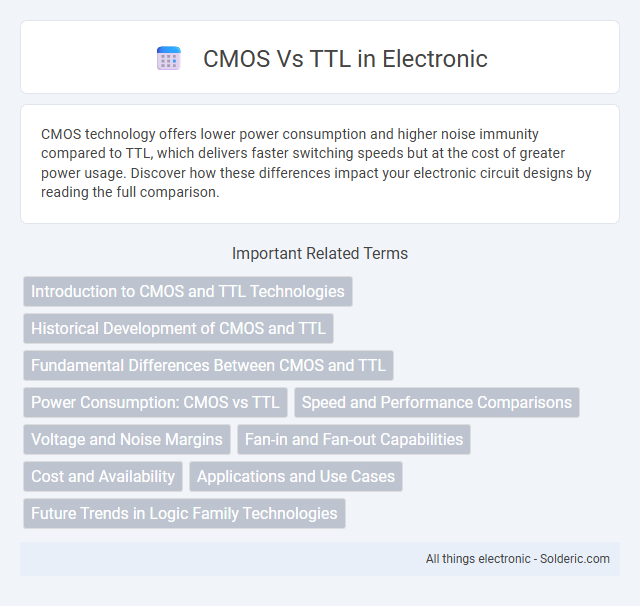CMOS technology offers lower power consumption and higher noise immunity compared to TTL, which delivers faster switching speeds but at the cost of greater power usage. Discover how these differences impact your electronic circuit designs by reading the full comparison.
Comparison Table
| Feature | CMOS (Complementary Metal-Oxide-Semiconductor) | TTL (Transistor-Transistor Logic) |
|---|---|---|
| Power Consumption | Low power, ideal for battery-operated devices | Higher power consumption compared to CMOS |
| Speed | Moderate speed, improved in advanced CMOS technologies | Generally faster switching speeds |
| Noise Immunity | High noise immunity | Lower noise immunity compared to CMOS |
| Input Impedance | Very high input impedance | Lower input impedance |
| Voltage Levels | Wide operating voltage range (3V to 15V) | Typically operates at 5V |
| Integration Density | High integration density | Lower integration density |
| Cost | Generally lower cost due to higher integration | Higher cost for complex circuits |
| Applications | Used in microprocessors, memory ICs, low-power circuits | Used in older digital circuits, industrial applications |
Introduction to CMOS and TTL Technologies
CMOS (Complementary Metal-Oxide-Semiconductor) and TTL (Transistor-Transistor Logic) represent two fundamental digital logic families used in electronic circuits. CMOS technology features low power consumption and high noise immunity, making it ideal for battery-operated devices, while TTL circuits are known for faster switching speeds and robust performance in noisy environments. Understanding the differences in their electrical characteristics and applications can help optimize Your electronic design choices.
Historical Development of CMOS and TTL
TTL (Transistor-Transistor Logic) emerged in the 1960s as a dominant digital logic family due to its fast switching speeds and ease of integration in early integrated circuits. CMOS (Complementary Metal-Oxide-Semiconductor) technology was developed later, gaining prominence in the 1970s and 1980s, favored for its low power consumption and high noise immunity. The historical evolution of CMOS allowed it to surpass TTL in scalability and efficiency, becoming the preferred choice for modern microprocessors and digital logic circuits.
Fundamental Differences Between CMOS and TTL
CMOS and TTL differ fundamentally in their transistor technology; CMOS uses complementary pairs of p-type and n-type MOSFETs, resulting in low static power consumption, while TTL relies on bipolar junction transistors, which consume more power even when idle. The input voltage levels and noise margins also vary, with CMOS providing higher noise immunity and broader input voltage ranges compared to TTL. Your choice between CMOS and TTL impacts speed, power efficiency, and compatibility with other digital logic families in electronic circuits.
Power Consumption: CMOS vs TTL
CMOS technology exhibits significantly lower power consumption compared to TTL, primarily due to its input transistors operating with negligible static current. TTL circuits draw continuous current even when in a steady state, leading to higher overall energy usage. Consequently, CMOS is preferred in battery-powered and energy-efficient applications.
Speed and Performance Comparisons
CMOS technology offers lower power consumption and faster switching speeds in advanced processes, making it ideal for high-density integrated circuits, whereas TTL circuits provide faster switching times in certain legacy designs due to their bipolar junction transistors. CMOS devices excel in high-speed applications with propagation delays often below a nanosecond, while TTL circuits typically exhibit slightly higher delays ranging from a few to tens of nanoseconds. The performance gap narrows as CMOS fabrication technology advances, enabling superior speed, noise margins, and integration levels compared to traditional TTL families like 74xx series.
Voltage and Noise Margins
CMOS technology operates at a wider voltage range, typically 3 to 15 volts, with higher noise margins around 1.5 to 3 volts, enhancing signal integrity and reducing susceptibility to interference. TTL circuits generally function at 5 volts with lower noise margins, approximately 0.4 to 0.8 volts, making them more sensitive to voltage fluctuations. The superior noise immunity of CMOS ensures better performance in electrically noisy environments compared to TTL logic.
Fan-in and Fan-out Capabilities
CMOS technology offers higher fan-in capabilities due to its high input impedance, allowing multiple inputs without significant signal degradation. TTL circuits typically have lower fan-in limits because of their lower input impedance and current requirements. In terms of fan-out, CMOS devices support more outputs as inputs because they draw minimal input current, whereas TTL devices have limited fan-out due to higher input current consumption.
Cost and Availability
CMOS technology generally offers lower cost and higher availability due to its widespread use in modern integrated circuits and efficient manufacturing processes. TTL components tend to be more expensive and less readily available as they are considered legacy technology primarily used in niche applications. Your choice between CMOS and TTL should consider budget constraints and the ease of sourcing components for your specific project.
Applications and Use Cases
CMOS technology is widely used in battery-powered devices and portable electronics due to its low power consumption and high noise immunity, making it ideal for smartphones, digital watches, and sensors. TTL circuits are preferred in high-speed applications requiring robust switching performance, such as in industrial controls, automotive electronics, and legacy digital systems. Depending on your specific application needs--whether power efficiency or speed--you can choose CMOS for energy-sensitive designs or TTL for faster, more durable operations.
Future Trends in Logic Family Technologies
Future trends in logic family technologies emphasize increasing integration, lower power consumption, and higher switching speeds, with CMOS (Complementary Metal-Oxide-Semiconductor) gaining dominance over TTL (Transistor-Transistor Logic) due to its scalability and efficiency. Innovations in CMOS focus on reducing leakage currents and enhancing performance in nanoscale devices, making it ideal for advanced applications like AI and IoT. Your designs will benefit from CMOS's ability to support complex, low-power logic circuits, ensuring longevity in evolving electronic systems.
CMOS vs TTL Infographic

 solderic.com
solderic.com